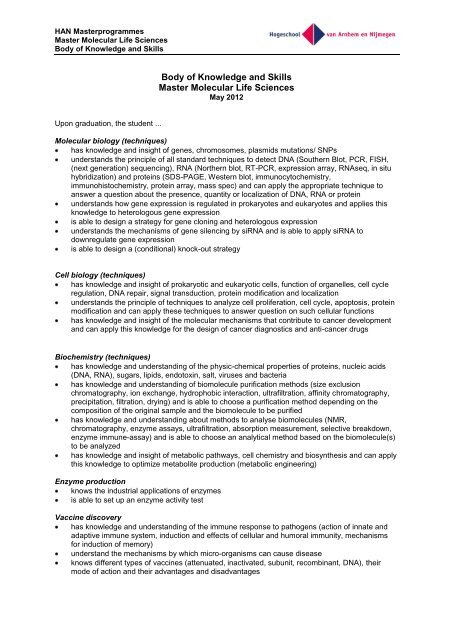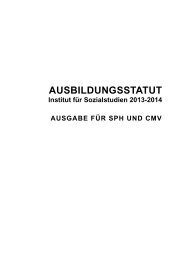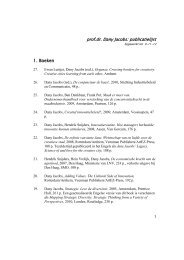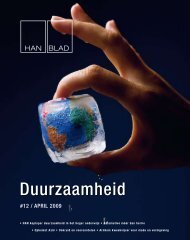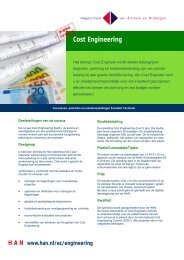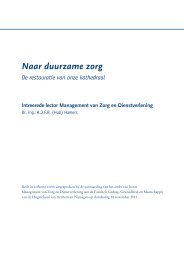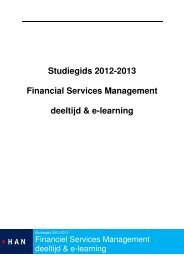Body of Knowledge and Skills Master Molecular Life Sciences
Body of Knowledge and Skills Master Molecular Life Sciences
Body of Knowledge and Skills Master Molecular Life Sciences
You also want an ePaper? Increase the reach of your titles
YUMPU automatically turns print PDFs into web optimized ePapers that Google loves.
HAN <strong>Master</strong>programmes<br />
<strong>Master</strong> <strong>Molecular</strong> <strong>Life</strong> <strong>Sciences</strong><br />
<strong>Body</strong> <strong>of</strong> <strong>Knowledge</strong> <strong>and</strong> <strong>Skills</strong><br />
<strong>Body</strong> <strong>of</strong> <strong>Knowledge</strong> <strong>and</strong> <strong>Skills</strong><br />
<strong>Master</strong> <strong>Molecular</strong> <strong>Life</strong> <strong>Sciences</strong><br />
May 2012<br />
Upon graduation, the student ...<br />
<strong>Molecular</strong> biology (techniques)<br />
has knowledge <strong>and</strong> insight <strong>of</strong> genes, chromosomes, plasmids mutations/ SNPs<br />
underst<strong>and</strong>s the principle <strong>of</strong> all st<strong>and</strong>ard techniques to detect DNA (Southern Blot, PCR, FISH,<br />
(next generation) sequencing), RNA (Northern blot, RT-PCR, expression array, RNAseq, in situ<br />
hybridization) <strong>and</strong> proteins (SDS-PAGE, Western blot, immunocytochemistry,<br />
immunohistochemistry, protein array, mass spec) <strong>and</strong> can apply the appropriate technique to<br />
answer a question about the presence, quantity or localization <strong>of</strong> DNA, RNA or protein<br />
underst<strong>and</strong>s how gene expression is regulated in prokaryotes <strong>and</strong> eukaryotes <strong>and</strong> applies this<br />
knowledge to heterologous gene expression<br />
is able to design a strategy for gene cloning <strong>and</strong> heterologous expression<br />
underst<strong>and</strong>s the mechanisms <strong>of</strong> gene silencing by siRNA <strong>and</strong> is able to apply siRNA to<br />
downregulate gene expression<br />
is able to design a (conditional) knock-out strategy<br />
Cell biology (techniques)<br />
has knowledge <strong>and</strong> insight <strong>of</strong> prokaryotic <strong>and</strong> eukaryotic cells, function <strong>of</strong> organelles, cell cycle<br />
regulation, DNA repair, signal transduction, protein modification <strong>and</strong> localization<br />
underst<strong>and</strong>s the principle <strong>of</strong> techniques to analyze cell proliferation, cell cycle, apoptosis, protein<br />
modification <strong>and</strong> can apply these techniques to answer question on such cellular functions<br />
has knowledge <strong>and</strong> insight <strong>of</strong> the molecular mechanisms that contribute to cancer development<br />
<strong>and</strong> can apply this knowledge for the design <strong>of</strong> cancer diagnostics <strong>and</strong> anti-cancer drugs<br />
Biochemistry (techniques)<br />
has knowledge <strong>and</strong> underst<strong>and</strong>ing <strong>of</strong> the physic-chemical properties <strong>of</strong> proteins, nucleic acids<br />
(DNA, RNA), sugars, lipids, endotoxin, salt, viruses <strong>and</strong> bacteria<br />
has knowledge <strong>and</strong> underst<strong>and</strong>ing <strong>of</strong> biomolecule purification methods (size exclusion<br />
chromatography, ion exchange, hydrophobic interaction, ultrafiltration, affinity chromatography,<br />
precipitation, filtration, drying) <strong>and</strong> is able to choose a purification method depending on the<br />
composition <strong>of</strong> the original sample <strong>and</strong> the biomolecule to be purified<br />
has knowledge <strong>and</strong> underst<strong>and</strong>ing about methods to analyse biomolecules (NMR,<br />
chromatography, enzyme assays, ultrafiltration, absorption measurement, selective breakdown,<br />
enzyme immune-assay) <strong>and</strong> is able to choose an analytical method based on the biomolecule(s)<br />
to be analyzed<br />
has knowledge <strong>and</strong> insight <strong>of</strong> metabolic pathways, cell chemistry <strong>and</strong> biosynthesis <strong>and</strong> can apply<br />
this knowledge to optimize metabolite production (metabolic engineering)<br />
Enzyme production<br />
knows the industrial applications <strong>of</strong> enzymes<br />
is able to set up an enzyme activity test<br />
Vaccine discovery<br />
has knowledge <strong>and</strong> underst<strong>and</strong>ing <strong>of</strong> the immune response to pathogens (action <strong>of</strong> innate <strong>and</strong><br />
adaptive immune system, induction <strong>and</strong> effects <strong>of</strong> cellular <strong>and</strong> humoral immunity, mechanisms<br />
for induction <strong>of</strong> memory)<br />
underst<strong>and</strong> the mechanisms by which micro-organisms can cause disease<br />
knows different types <strong>of</strong> vaccines (attenuated, inactivated, subunit, recombinant, DNA), their<br />
mode <strong>of</strong> action <strong>and</strong> their advantages <strong>and</strong> disadvantages
HAN <strong>Master</strong>programmes<br />
<strong>Master</strong> <strong>Molecular</strong> <strong>Life</strong> <strong>Sciences</strong><br />
<strong>Body</strong> <strong>of</strong> <strong>Knowledge</strong> <strong>and</strong> <strong>Skills</strong><br />
is able to choose a vaccine antigen, adjuvant <strong>and</strong> administration route depending on the immune<br />
response that is required <strong>and</strong> on practical aspect<br />
knows different vaccine production platforms, their advantages <strong>and</strong> disadvantages<br />
is able to design experiments to test the potency <strong>of</strong> a vaccine<br />
Development <strong>of</strong> diagnostic tests<br />
knows different types <strong>of</strong> diagnostic tests, their principle <strong>of</strong> action <strong>and</strong> their advantages <strong>and</strong><br />
disadvantages<br />
is able to define the importance <strong>of</strong> sensitivity, specificity, <strong>and</strong> practical aspects such as costs,<br />
duration or required staff training based on the desired application <strong>of</strong> the diagnostic test<br />
has insights in the principles, advantages <strong>and</strong> disadvantages <strong>of</strong> different diagnostic tests, e.g.<br />
serology <strong>and</strong> molecular diagnostics: ELISA, (M)IFA, (q),(multiplex)PCR, MFI, IB, HAI<br />
is able to choose a type <strong>of</strong> diagnostic test based on the required specificity, sensitivity <strong>and</strong><br />
practical aspects such as duration, requirement for staff training<br />
Drugs Discovery, Development <strong>and</strong> Delivery<br />
knows <strong>and</strong> underst<strong>and</strong>s the principle <strong>of</strong> different types <strong>of</strong> drugs <strong>and</strong> treatment approaches (small<br />
molecules, antibodies, gene therapy, antibiotics <strong>and</strong> anti-virals, chemotherapy, radiotherapy),<br />
their advantages <strong>and</strong> disadvantages<br />
is able to choose one type <strong>of</strong> drug as an active pharmaceutical ingredient depending on the<br />
desired biological effect<br />
is able to choose a delivery system based on desired selectivity <strong>and</strong> bio-availability<br />
is able to design a strategy to measure the bio-availability <strong>of</strong> the drug<br />
is able to choose appropriate in vitro <strong>and</strong> in vivo assays to test the efficacy <strong>and</strong> the toxicology <strong>of</strong><br />
a drug<br />
knows with animal models can be used to test drugs, <strong>and</strong> the advantages <strong>and</strong> disadvantages <strong>of</strong><br />
these models<br />
knows the different phases <strong>of</strong> clinical studies <strong>and</strong> what is required to enter the clinical phase <strong>of</strong><br />
drug development<br />
Quality assurance <strong>and</strong> quality control<br />
is able to define quality requirement for products <strong>and</strong> processes based on regulatory guidelines<br />
(ICH guidelines)<br />
is able to describe a target product pr<strong>of</strong>ile <strong>and</strong> critical quality attributes<br />
is able to design a strategy to validate a diagnostic test<br />
Process development <strong>and</strong> optimization<br />
knows the advantages <strong>and</strong> disadvantages <strong>of</strong> different production strains <strong>and</strong> is able to choose a<br />
suitable production strain for the production <strong>of</strong> specific proteins<br />
is able identify critical parameters in the process<br />
tests critical parameters in the production process (USP <strong>and</strong> DSP) <strong>and</strong> interprets the outcome<br />
is aware <strong>of</strong> the fact that scaling up or down requires process re-optimization<br />
Statistics <strong>and</strong> experimental design<br />
underst<strong>and</strong>s the meaning <strong>of</strong> the statistical terms: statistical hypotheses, type <strong>of</strong> variable<br />
(continuous / categorical), association versus causation, confounding variables, variation, normal<br />
distribution, population versus sample, dependent <strong>and</strong> independent observations, point-estimate<br />
<strong>and</strong> confidence interval, descriptive statistics, p-value <strong>and</strong> statistical significance, logtransformation<br />
underst<strong>and</strong>s the principle <strong>and</strong> application <strong>of</strong> statistical hypothesis, hypothesis test, one- or twotailed<br />
test, p-value; adjustment for multiple testing<br />
is able to translate the research question into an appropriate statistical question, experimental<br />
setup <strong>and</strong> corresponding statistical analysis<br />
has awareness <strong>of</strong> power <strong>and</strong> sample size calculations<br />
underst<strong>and</strong>s the meaning <strong>of</strong> experimental design <strong>and</strong> the terms: double blind, completely<br />
r<strong>and</strong>omized design, r<strong>and</strong>omized block design, controlled experiment, case-control study, crossover<br />
design, factorial design, screening design<br />
is able to design <strong>and</strong> analyze a process optimization experiment using experimental design
HAN <strong>Master</strong>programmes<br />
<strong>Master</strong> <strong>Molecular</strong> <strong>Life</strong> <strong>Sciences</strong><br />
<strong>Body</strong> <strong>of</strong> <strong>Knowledge</strong> <strong>and</strong> <strong>Skills</strong><br />
underst<strong>and</strong>s the differences between superiority versus equivalence testing<br />
Is able to choose the appropriate statistical method (e.g. t-test, ANOVA, regression) to analyze<br />
continuous data<br />
is able to determine the accuracy, sensitivity <strong>and</strong> specificity <strong>of</strong> a diagnostic test; is able to<br />
interpret chi2 tests, logistic regression, odds ratios <strong>and</strong> ROC curves<br />
is able to interpret a Kaplan Meier curve<br />
is able to report the results with tables <strong>and</strong> graphics<br />
is able to use statistical s<strong>of</strong>tware (e.g. SPSS or minitab)<br />
Bioinformatics<br />
The student is familiar with biological databases Databases (NCBI, OMIM, UniProt, EBI)<br />
Gene annotation:<br />
is able to identify the ORF (introns/exons)<br />
is able to predict the gene function by comparing the ORF with genes with known functions<br />
is able to predict the structure <strong>and</strong> conserved domains <strong>of</strong> the protein<br />
is able to predict the post-translational modifications<br />
is able to use s<strong>of</strong>tware for primer design <strong>and</strong> analyses, <strong>and</strong> for the analysis <strong>of</strong> restriction sites in a<br />
DNA sequence<br />
knows that structure analysis can be used to predict the function <strong>of</strong> the biomolecule <strong>and</strong> to<br />
discover interaction partners/ drugs<br />
underst<strong>and</strong>s the principle steps in analyzing high-throughput data obtained by –omics approaches.<br />
has analyzed <strong>and</strong> interpreted a limited number <strong>of</strong> high-throughput data (using Galaxy s<strong>of</strong>tware)<br />
<strong>and</strong> is able to communicate to specialists about such analyses<br />
Intellectual properties<br />
is aware <strong>of</strong> the rights derived from intellectual properties <strong>and</strong> underst<strong>and</strong>s which implications these<br />
have for the production <strong>of</strong> generics <strong>and</strong> biosimilars<br />
is able to use patent databases to identify patent blocks<br />
is aware that he/she needs to contact patent experts if he/she is not sure how to interpret patent<br />
databases<br />
Bio-business<br />
underst<strong>and</strong>s the meaning <strong>of</strong> the terms business models <strong>and</strong> business development, business<br />
value <strong>and</strong> financing<br />
is able to translate his/her projects plans in a concise business plan<br />
Inter-personal skills<br />
has insight in different communication styles<br />
knows the principles <strong>of</strong> situational leadership<br />
is aware <strong>of</strong> the value <strong>of</strong> networks <strong>and</strong> knows strategies to set up <strong>and</strong> maintain them<br />
is aware <strong>of</strong> intercultural differences<br />
This <strong>Body</strong> <strong>of</strong> <strong>Knowledge</strong> <strong>and</strong> <strong>Skills</strong> was verified by representatives <strong>of</strong> the pr<strong>of</strong>essional practice <strong>of</strong> the<br />
HAN <strong>Master</strong> <strong>Molecular</strong> <strong>Life</strong> <strong>Sciences</strong> in March 2012.


